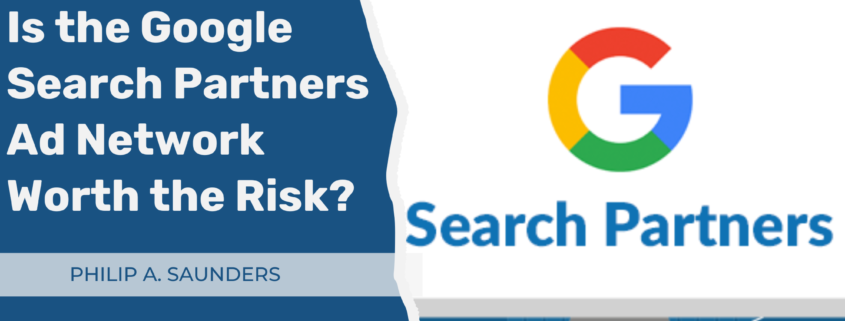The Truth Behind the Google Search Partners Ad Network: What Home Services Companies Need to Know About Click Fraud and Brand Safety
This morning I read an article on the Search Engine Roundtable discussing an uptick in click fraud seen across the Google Search Partners (GSP) ad network. This is nothing new and one of the main reasons I avoid selecting this option when running Google Search campaigns for my clients. Below I attempt to explain the issue in more detail for those that are unaware of the risks of advertising on the GSP network.
For home services companies that outsource their Google PPC marketing to an outside agency, it would be in your best interest to see if the agency is advertising on the GSP network. In my experience this is the fastest way to spend your budget with generally minimal return.
Is the Google Search Partners Network Worth the Risk?
The digital marketing world is constantly evolving, and home services companies rely heavily on platforms like Google Ads to generate leads and increase visibility. However, one often-overlooked component is the Google Search Partners ad network, which can be both an opportunity and a risk for advertisers. The GSP network includes third-party sites where your ads might appear, but it has been plagued with concerns about fraud, brand safety, and transparency. Understanding these risks is vital for businesses like yours to make informed decisions about ad spend.
What is the Google Search Partners Network?
The Google Search Partners Network extends the reach of your ads beyond Google’s search engine results pages (SERPs) to other third-party websites, including smaller search engines, apps, and directories. By doing this, Google provides advertisers with broader exposure, theoretically improving click-through rates and conversions. However, the GSP’s lack of transparency on where ads appear, coupled with fraud issues, has made it a controversial option for many businesses, including those in the home services industry.
Click Fraud in the Google Search Partners Network
Click fraud is a significant concern within the Google Search Partners Network. This issue arises when either competitors or malicious entities deliberately click on ads to drain a company’s ad budget without any real intent to convert. In some cases, the fraud stems from webmasters hosting these ads on their websites to increase their revenue through Google’s AdSense program. These site owners might encourage invalid clicks or even use automated tools to inflate click numbers, ultimately harming advertisers who are paying for those clicks without seeing any meaningful returns.
While Google employs various methods to detect and prevent click fraud, such as using automated filters and manual reviews, these systems are not foolproof. Google does offer credits for invalid activity, but advertisers still risk losing substantial sums to fraudulent clicks, especially if the fraud is not detected promptly.
For home services companies that often operate within narrow geographic areas, click fraud can be devastating. Competing for local customers is already challenging, and fraud further inflates the cost of acquiring genuine leads.
Brand Safety Concerns with GSP
Brand safety has become another sticking point for the Google Search Partners Network. Numerous reports suggest that ads placed through this network have appeared on websites with objectionable content, such as pirated material or even explicit content, which can severely damage a brand’s reputation. According to research, some high-profile companies were shocked to find their ads displayed on sites they had explicitly blocked in their ad settings. This lack of control over where your ads are shown can result in wasted ad spend and harm to your brand’s image.
Home services companies, which typically rely on building trust within their local communities, must be especially cautious. Ads showing up on disreputable websites can erode consumer trust and reduce the effectiveness of marketing campaigns. Google has introduced some mechanisms to combat these issues, such as allowing advertisers to opt out of the GSP network entirely, but the control remains limited.
The Transparency Problem
One of the major criticisms leveled at the Google Search Partners Network is the lack of transparency. Advertisers have little to no control over where their ads appear within the network, making it difficult to evaluate the performance and efficacy of ad placements. While Google claims that ads placed on the GSP network can drive additional traffic, there’s limited data available to assess whether these impressions and clicks are genuinely contributing to conversions.
This lack of visibility is especially concerning for home services businesses, where tight marketing budgets need to be optimized for maximum ROAS. The inability to track exactly where ads are running can lead to inefficiencies and wasted spending. As a result, some experts recommend excluding the GSP network from campaigns until Google provides more robust reporting tools.
Google’s Efforts to Address Fraud and Brand Safety
In response to mounting pressure from advertisers and industry watchdogs, Google has introduced several measures to improve the integrity of its ad networks. These include enhanced content enforcement through automated systems and human reviews, regular sweeps for policy violations, and the suspension or banning of violators. Google has also increased its scrutiny of invalid traffic (IVT) and offers advertisers credit for detected fraud.
While these steps represent progress, many advertisers remain cautious. Home services companies, in particular, must weigh the potential benefits of increased reach against the risks of click fraud and brand safety breaches. It’s crucial to continually monitor ad performance and refine your targeting settings to ensure that your ads are reaching the right audience
What Home Services Companies Should Do
For home services businesses, the risks associated with the Google Search Partners Network can be mitigated by taking several proactive steps:
- Review and Refine Your Campaign Settings: Opt out of the GSP network if you’re experiencing poor results or suspect that your ads are being placed on low-quality or inappropriate sites. Focus your budget on Google’s primary search engine instead.
- Monitor Ad Performance Closely: Use tools like Google Analytics to track click patterns, especially if you notice unusually high click volumes that don’t correspond to conversions. Setting up conversion tracking is critical to identifying potential fraudulent activity.
- Leverage Negative Keywords and Blocklists: Make sure your campaigns are set up to exclude irrelevant or potentially harmful placements. Regularly update your negative keyword lists and block known low-quality sites.
- Experiment with Limited GSP Use: If you decide to use the Google Search Partners Network, start small. Test it with branded campaigns or remarketing lists for search ads (RLSA), where users are already somewhat familiar with your company, before expanding to broader audiences.
Similar Posts:
- Yelp vs. Google: Why Home Services Companies Are Betting on Google Reviews
- Google’s LSA Update (February 2024): A Fast Track to Ad Spend Disaster?
- Lessons from the Legal Sector: Maximize Home Services ROI with a Balanced Approach
Mr. Saunders serves as Mesa’s Vice President of Marketing, bringing with him a wealth of experience in strategic marketing and operations. In this role, Mr. Saunders is responsible for overseeing all marketing activities, utilizing a blend of traditional and digital strategies to enhance brand presence and profitability, managing a multi-million dollar marketing budget across various media platforms, and leading the continued implementation of CRM systems to streamline customer engagement and drive business growth.




Leave a Reply
Want to join the discussion?Feel free to contribute!